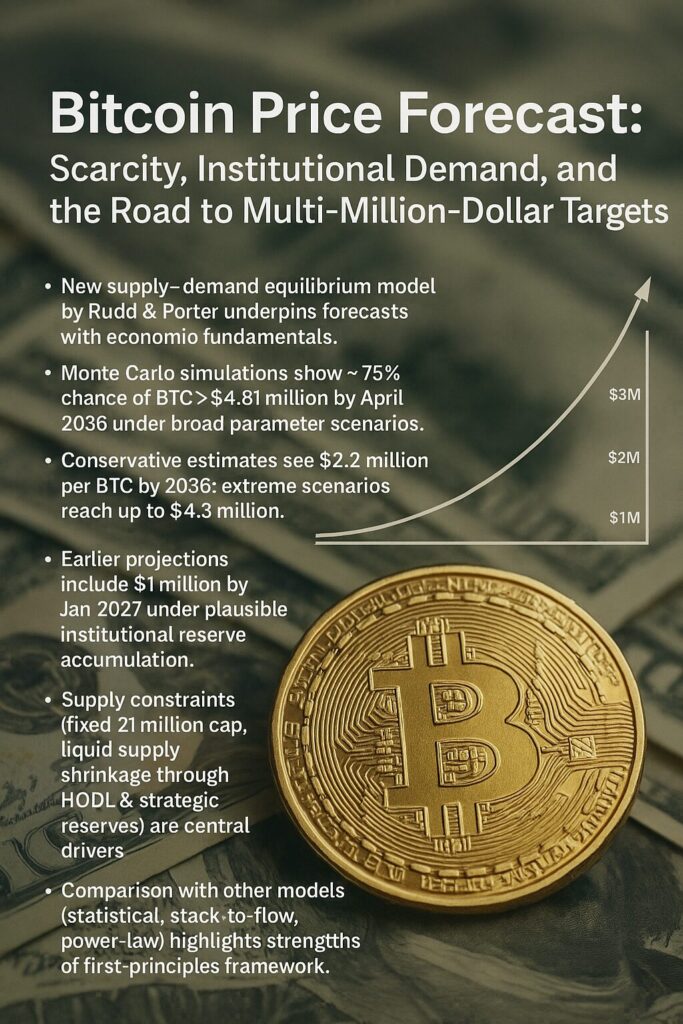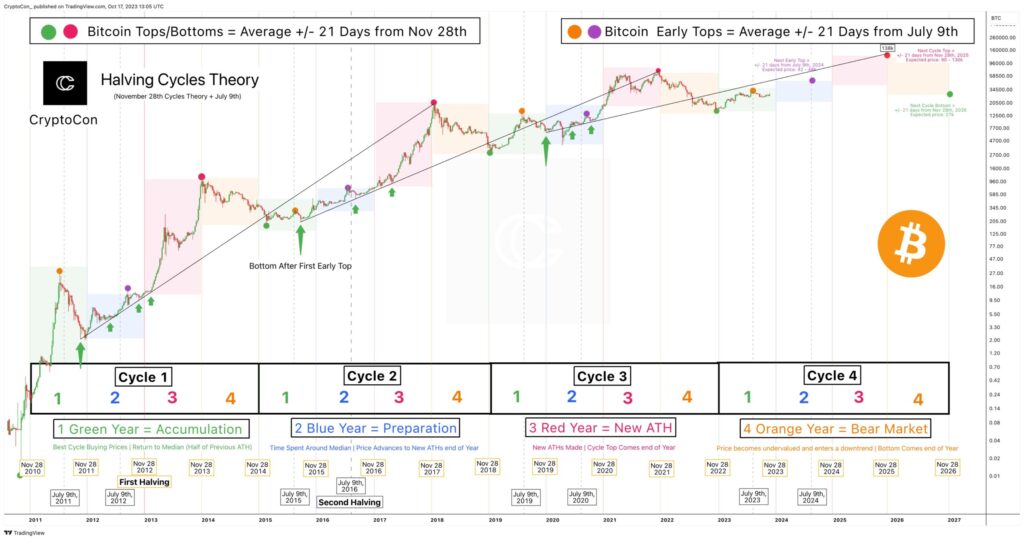
Main Points :
- New economic supply–demand models forecast Bitcoin (BTC) may reach multi‑million dollar valuations by 2036.
- Model separates investor time preference and price sensitivity using Epstein‑Zin utility and applies Monte Carlo simulation for enhanced forecasting.
- Key drivers: immutable 21 million cap, declining liquid supply (HODLing, institutional/sovereign accumulation), and constrained withdrawals.
- Conservative scenario: ~$2.2 million by 2036; bullish: ~$5 million by 2031; hyperbolic: ~$4.3 million by 2036.
- Crossing $1 million by early 2027 is plausible under demand surges and supply shock dynamics.
- Institutional buying (e.g. ETF flows) and supply removal intensify scarcity and could catalyze steep price rises.
- Complementary forecasts (e.g. ARK’s $1.5 million by 2030; Tom Lee’s $150K by year‑end, long‑term $3 million) reinforce momentum.
- Graphical illustration to aid conceptual understanding.
- Comprehensive summary and forward view for blockchain practitioners and yield‑seeking readers.
1. Introduction: A New Lens on Bitcoin Forecasting
In recent months, academic economists Murray A. Rudd and Dennis Porter have introduced a novel price forecasting model for Bitcoin (BTC), grounded in fundamental economic theory rather than purely historical or statistical extrapolation. Their work highlights how Bitcoin’s inelastic, capped supply and evolving demand—especially from institutional and sovereign actors—interact to shape future price trajectories. Instead of relying on curve‑fitting to past cycles, their model provides a principled framework that can be parameterized based on real‑world behavior and policy assumptions. Greenlighting this rigorously calibrated approach may offer investors and blockchain professionals deeper insight intoBTC’s long‑term role as a deflationary, scarcity‑driven asset.
2. Model Foundations and Methodology
2.1 Inelastic Supply & Liquid Supply Dynamics
Bitcoin is governed by a hard cap of 21 million coins. With halvings reducing issuance over time, over 93% has already been issued as of April 2024. Importantly, much of it is illiquid—long‑term holding (“HODL”), lost keys, and institutional reserves mean that only a portion of total supply is accessible for trading. This supply scarcity is foundational to the model’s dynamics.
2.2 Supply-Demand Equilibrium and CES Demand
The model uses a rigid (vertical) supply curve and a constant elasticity of substitution (CES) demand curve to simulate equilibrium price paths. It starts from the April 2024 halving as a base point—where issuance dropped, and price stood at about $64,858—and simulates day‑by‑day evolution by adjusting both issuance schedules and varying demand parameters.
2.3 Epstein-Zin Utility & Monte Carlo Simulation
To capture investor behavior more accurately, the researchers integrate Epstein‑Zin utility, enabling separation of investors’ time preference and price sensitivity. They then employ Monte Carlo simulation (10,000 draws) to explore a wide range of scenarios, creating probabilistic outcomes rather than single-point forecasts.
3. Forecast Scenarios: What the Numbers Say
3.1 Multi-Million-Dollar Price Potential by 2036
The core result of Monte Carlo analysis shows a 75% probability that Bitcoin’s price will exceed $4.81 million by April 2036, with many plausible paths landing in the low to mid‑millions. Hyperbolic price leaps (tens of millions) only occur under extreme conditions of extreme supply depletion and low withdrawal sensitivity.
3.2 Scenario Comparison
Other published interpretations outline three key scenarios:
- Conservative: Modest demand growth and institutional accumulation → ~$2.2 million by 2036.
- Bullish: 30× demand increase, managed withdrawal rates → reaching $5 million by early 2031.
- Hyperbolic: 40× demand growth and 4,000 BTC/day withdrawal from liquid supply → ~$4.3 million by 2036.
3.3 Early Seven-Digit Plateau: $1 Million by 2027
Peer‑reviewed modeling also suggests that, under dramatic demand shifts, Bitcoin could surpass $1 million before January 2027. This underscores how supply constraints may cause steep short‑term price movements even before the 2030s.
4. Drivers: What Could Push BTC to Infinity?
4.1 Institutional and Sovereign Accumulation
ETF purchases alone have averaged around 285 BTC/day by late 2024, steadily removing liquidity from exchanges. Meanwhile, proposals like Senator Lummis’s potential $1 million BTC reserve, adding ~550 coins/day over five years, show how institutional buying could drastically drain liquid supply.
4.2 Layer-2 and DeFi Lock-ups
Beyond financial actors, DeFi protocols, Layer‑2 solutions, and corporate treasury strategies increasingly lock up BTC, intensifying supply shortages.
5. Broader Market Backdrop and Complementary Forecasts
While Rudd & Porter’s model offers deep fundamental insights, other analysts also project dramatic growth:
- Cathie Wood (ARK) expects $1.5 million by 2030, citing institutional capital inflows.
- Tom Lee (Fundstrat) forecasts $150,000 by year‑end, potentially rising to $3 million long‑term.
- Others expect Bitcoin to outshine gold as a store of value—e.g., analysts predicting $200,000 by late‑2025, $1 million by 2033.

6. Implications for Investors and Blockchain Practitioners
- Strategic Asset Allocation: This model reinforces Bitcoin’s potential as a finite, scarcity‑driven store of value—valuable for portfolios seeking inflation hedge or asymmetric upside.
- Supply Monitoring is Key: Investors should track liquid supply metrics, ETF flows, HODL waves, and institutional accumulation as predictive indicators.
- Risks & Volatility: Hyperbolic scenarios arise only under extreme supply drain—timing and policy shifts could change trajectory steeply. Investors should build robust risk controls.
- Blockchain Utility: Beyond price speculation, increasing BTC lock‑ups in DeFi or Layer‑2 underscore its utility as collateral and capital—not just commodity.
7. Conclusion: Toward a Fundamentals-Driven BTC Outlook
Murray Rudd and Dennis Porter’s supply–demand equilibrium model provides a robust economic foundation for forecasting Bitcoin’s long‑term price trajectory. Grounded in first principles and flexible in parameterization, it reveals that BTC may reasonably climb into the low‑to‑mid‑millions by 2036, with conceivable pathways to exceed $1 million by 2027. While not a prediction of certitude, it offers a powerful framework for yield‑seeking investors and blockchain practitioners: one that replaces extrapolative glamour with grounded economic reasoning.
Bitcoin’s finite supply, augmented by institutional demand and liquid supply depletion, may usher in a new era of scarcity and valuation. The model invites stakeholders to monitor measurable variables—withdrawal sensitivity, liquid supply thresholds, accumulation behavior—and calibrate strategies accordingly. Taken together with broader market optimism and adoption dynamics, this model suggests Bitcoin’s potential to evolve into a major strategic asset class in the coming decade.

